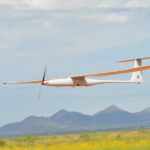Skydweller, an uncrewed solar-powered aircraft which has a wingspan greater than a 747, has completed the world’s first successful autonomous, uncrewed flight of a large solar-powered aircraft, taking off, flying and landing by itself, without humans on-board or in control, from Stennis International Airport in the United States.
“This is a true, world-changing first in the aerospace industry,” said Robert Miller, CEO, Skydweller Aero, the aircraft’s manufacturer, which is the only global manufacturer of large, autonomous solar-powered aircraft capable of perpetual flight. “Our fleet of uncrewed aircraft will enable a multitude of long-duration missions that support national security and non-terrestrial communications with revolutionary cost savings.”
Skydwellers can be deployed for long-duration missions such as providing continuous aerial overage above conflict zones, surveilling naval activity in contested waters without risking pilots’ lives, detecting drug smugglers and pirates at sea, and tracking wildlife migration and poaching in Africa.
“This really is a first when it comes to national security and protecting Americans,” said Senator Roger Wicker, ranking member of the U.S. Senate Armed Services Committee who unveiled a Skydweller aircraft to the public last month. “It really is great news and it’s only the beginning.”
Skydweller aircraft are capable of perpetual flight, staying aloft for 90 days or more, at altitudes of up to 45,000 feet. In contrast, current combustion-powered aircraft, including piloted aircraft and drones, are limited to approximately 40 hours maximum flight time, limited by the endurance of pilots, the amount of fuel a conventional aircraft can carry, and the need for frequent maintenance.
“We are applying cutting-edge, 21st century materials science, artificial intelligence, and software development to an industry that has spent more than 100 years building piloted, combustion-based aircraft,” Miller continued. “This allows Skydweller to leap ahead of heritage aircraft manufacturers in terms of aircraft performance, flight duration, and cost effectiveness.”
Subscribe to the FINN weekly newsletter
You may also be interested in
CityAirbus NextGen makes its debut

